Ryan Hall's Blog, page 135
August 29, 2017
Behind The Scenes At The Cover Athlete Contest Shoot
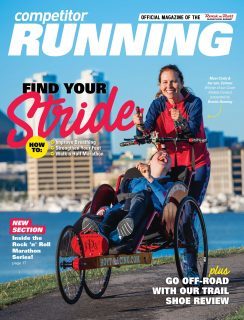
Out of thousands of applicants, Cindy Spiva from San Diego won our Cover Athlete Contest presented by Brooks Running. Spiva graces the cover of the September issue of the magazine with her 14-year-old son Cormac Evans, who she regularly pushes during runs and at races. Spiva’s story of courage, love (of running and family) and perseverance resonated, and she was selected as the winner, along with nine other finalists. Here’s a behind-the-scenes look at the cover shoot, which took place in Seattle and included a tour of the Brooks headquarters and once-in-a-lifetime memories with her son.
RELATED: Read The Full Story Of The Mother-Son Duo That Won Our Cover Athlete Contest
The post Behind The Scenes At The Cover Athlete Contest Shoot appeared first on Competitor.com.
Meet The Inspiring Finalists From Our Cover Athlete Contest
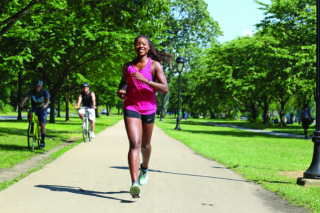
Meet the finalists! Inspiration abounds from the runners who round out the top-10 picks from our September issue cover athlete contest.
Want to find out who won? Meet the winner here!
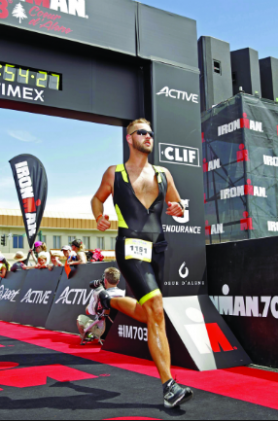
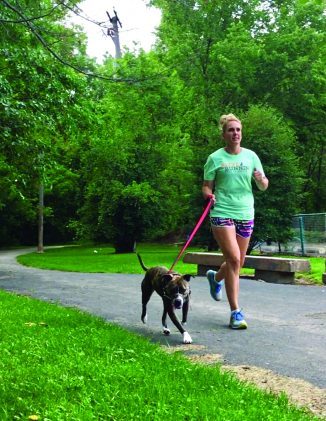
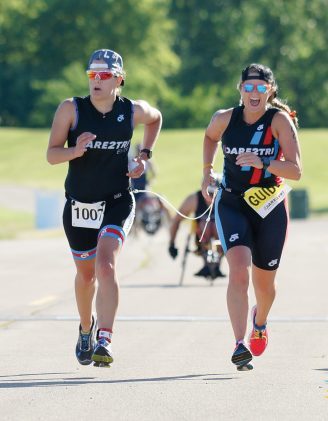
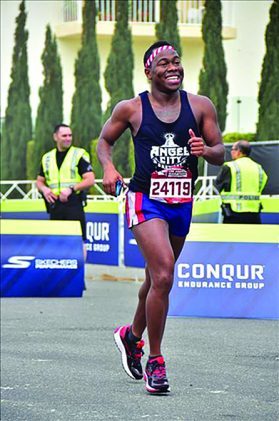
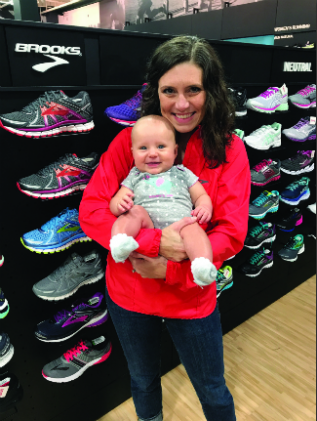


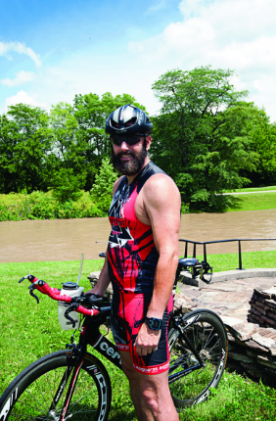

The post Meet The Inspiring Finalists From Our Cover Athlete Contest appeared first on Competitor.com.
Meet The Mother-Son Duo That Won Our Cover Athlete Contest
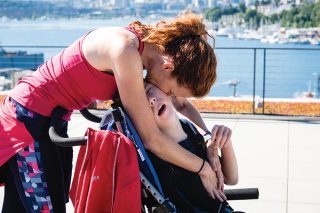

Meet the nine other cover athlete finalists here!
Cindy Spiva begins to jog with a nervous smile through Gas Works Park, just north of downtown Seattle. Her nerves are understandable. Spiva isn’t used to the attention, yet she’s fully aware of the photographer, the videographer and the half-dozen representatives from Brooks and Competitor Running who are watching her every step.
Cormac Evans doesn’t need to force a smile. Spiva’s 14-year-old son can’t talk, isn’t independently mobile and is mostly paralyzed on the right side of his body. Yet his grin is ear to ear as Mom pushes him through the park in a racing chair, both of them head to toe in new Brooks apparel and shoes. A slight breeze kicks up off of Lake Union, cooling the Pacific Northwest sun on a rare day when it doesn’t compete with Seattle clouds. For Spiva, the attention is new and exciting. For Cormac, it’s pure bliss.
“Kids like Cormac are very rarely able to immerse themselves and fully participate in life around them,” says Spiva, who lives in San Diego. “But when we run, in that experience, he’s a 100 percent participant. So often he’s invisible. He’s ignored. He’s treated like a piece of furniture. But when we run, people see him. They give him high-fives. Even though I’m his legs, he’s a full participant.”
WATCH: Behind The Scenes At The Cover Athlete Contest Shoot
The pair is in Seattle because Spiva clicked a box. A friend on Facebook had participated in “The Big Endorsement” campaign (the new promotion pays any runner $1 to be an officially endorsed Brooks athlete). Spiva thought it was a cute idea, so she signed up too. There was also an option to enter the Competitor Running Cover Athlete Contest. The magazine’s editorial staff pored over more than a thousand submissions, narrowing the finalists down to a list of 10 (keep reading to meet the other amazing runners!). Spiva’s story of courage, love (of running and family) and perseverance resonated, and she was selected as the winner. Her trip to Seattle for the cover shoot included a tour of Brooks headquarters and once-in-a-lifetime memories with her son.

Cormac was born with hemimegalencephaly, a rare neurological disorder where one half of the brain is abnormally larger than the other. By five months, he was undergoing brain surgery where doctors removed most of the left side of his brain, essentially disconnecting the right side of his body and language centers.
Spiva, 50, only started running last year. She went to the Carlsbad 5000 to support one of Cormac’s friends and became enamored with the experience. And more importantly—how Cormac reacted. He loved it more than she did. She immediately downloaded a couch-to-5K app and promised herself she’d run a half marathon by the time she was 50. Two days after her birthday in February, Spiva ran the Divas Half Marathon in Temecula, Calif. Little did she know that months later she’d be on the cover of a national running magazine.
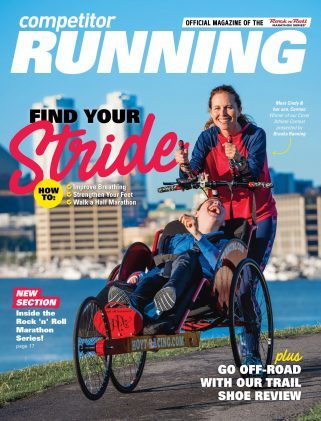
RELATED: Read the September 2017 Digital Edition of Competitor Magazine
“I don’t know if I really have words to explain what it was like, because I don’t consider myself an athlete or anyone of note,” says Spiva. “We’re everyman. We’re the 99.9 percent who go out and do our thing each day while watching the elites from afar. To have someone go ‘you’re noticeable,’ it’s crazy. And pretty cool.”
And yet it’s what Spiva didn’t say in her contest entry that might be the most telling about who she is. Four years ago, she was diagnosed with multiple sclerosis after waking one morning with impaired vision in one eye. A case of optic neuritis led to an MRI, which revealed “a brain full of lesions.” She didn’t disclose any of this until after she was selected the winner of the contest.
“I don’t really like things being about me. I like that this was about Cormac,” she says. “I’ve learned so much about the brain parenting Cormac that being handed my own diagnosis wasn’t a problem. I know what to do.”

So far, Spiva hasn’t had any episodes since that first one five years ago. Though the science is still out on whether running can help stave off MS, Spiva believes it’s helping to keep her brain and muscles sharp. She estimates that she runs between 15 and 30 miles per week. Sometimes it’s with Cormac, weather permitting. And sometimes she likes to go it alone on trails.
“I learned how to be an advocate for my son and myself, and I learned how to say no to doctors, which has been a very important tool,” says Spiva, who studied parasitic diseases in graduate school. “Most doctors have been respectful when I say no, because I usually have an educated reason. I believe in keeping my body moving and challenging it—especially on trails because [every] footfall is different. While I’m training my body and muscles to respond, I’m also training my brain.”

Now semi-retired, Spiva previously worked for 13 years at the San Diego Zoo in the education department. She teaches a museum studies course one month a year to graduate students through Johns Hopkins University and loves to write. But she also recognizes that taking care of Cormac is a full-time job. She has an aid. And her ex-husband, Keith, is involved with Cormac and their 18-year-old daughter, Chloe.
But running is just for mother and son. She’s found plenty of help from support groups online and within the running community and tries to be an example for those on the fence about getting involved in running.
“If I can do it, anyone can do it,” she says. “I just get out and move. I have my bad days and my great days. My goal is not to win any race we get into. It’s not even to place in my age group. It’s just to participate in life.
“We’ll just keep moving as long as we can and hope that we continue to keep moving.”
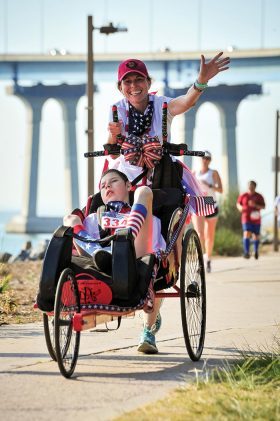
RELATED: Meet The Inspiring Finalists From Our Cover Athlete Contest
The post Meet The Mother-Son Duo That Won Our Cover Athlete Contest appeared first on Competitor.com.
Read the September 2017 Digital Edition of Competitor Magazine
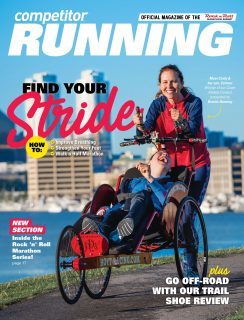
Our September issue has a brand new look! Flip through the redesigned issue to take a look at what’s different, including a new “Inside the Rock ‘n’ Roll Marathon Series” section. The September cover also features Cindy and her son Cormac as winners of our Cover Athlete Contest presented by Brooks Running. Read more about their amazing story and why they were chosen out of thousands of applicants (including inspiring stories from the nine finalists) to grace our cover. Plus, get an in-depth review of the season’s latest trail running shoes.
Find our print edition at a location near you with the store locator.
The post Read the September 2017 Digital Edition of Competitor Magazine appeared first on Competitor.com.
How To Find Motivation When You Don’t Feel Like Running
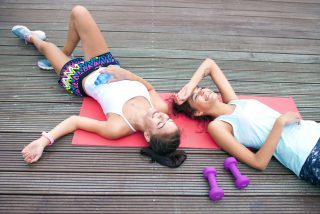
Even the most avid runners experience a day here or there when they just don’t feel like running. We’ve all been there.
Taking a day off from running may seem harmless, but it depends on why you don’t feel like it. If your reason is hunger, tiredness, physical strain or an overwhelming desire to be a couch potato, no harm done.
If, however, you find your enthusiasm waning, you may want to resist the urge to take a day off. Any healthy discipline takes determination and effort.
To help you fight the urge to slack on your running routine, below are some motivating tips. Some of these pointers are inspired by my personal experience as a clinician working with clients in treatment for substance abuse (for whom finding the motivation to stick with newfound sobriety is critical) and are proven to motivate those who need it most:
Set goals for yourself and track your progress.
Knowing why you’re running in the first place can help you set short and long-term goals for yourself, and determine a training program that aligns with these goals. If you’re running to lose weight, for example, it may help to invest in a training watch or smartphone app that helps you keep track of the number of calories you’re burning on your runs. Just the prospect of seeing the number of calories you’re burning with every 10 strides can be motivation enough.
Think about how good you’ll feel after running.
“Play it forward” is the lingo we sometimes use in the recovery field to help clients think through moments when they may feel inclined to relapse. If you’re weighing whether to run five miles or veg on the couch with a bag of potato chips and your favorite episode of Seinfeld, play the two scenarios forward to how you’ll feel afterwards. In many cases, the positive anticipation about how you’ll feel after you run can be a great incentive.
Schedule your runs.
Scheduling your runs—much in the same way you schedule other appointments—gives it priority. Conversely, when that chunk of time isn’t blocked off on your calendar, it’s easier to let it get crowded out by other commitments. Some people need this concrete visual reminder to stick with a running discipline, especially if a habit of daily exercise is new to them. When running is already on your schedule, it is also harder to turn down (it almost takes more effort to replace that space in your schedule with something else).
RELATED: 7 Tips For Fitting Fitness Into Your Busy Schedule
Give yourself visual cues to run.
The mere image of a syringe can prompt cravings in an addict who used to shoot up to get high. A similar dynamic can engender the development of healthy habits. For example, a friend of mine who once was a serious runner used to put her running shoes at the front door as self-motivation for those long, early morning runs. Other people go so far as to sleep in their running clothes, or put their running shoes on the floor next to their bed.
Run with others.
There is accountability in groups, and sometimes it’s more fun to run with others. Join a running club or pair up with a friend who is serious about getting in shape. This way, too, you increase your various motivations to run, so that on any given day when running itself isn’t doing it for you, the friendly camaraderie of others may still be a draw.
Get some fun running clothes.
Sometimes looking good can help you feel good—or at least can motivate you to try out your new athletic gear. Maybe it’s time to trade in that ratty old sports bra and T-shirt for some real runner’s clothing.
RELATED: What The Editors Can’t Run Without
Put on some motivational music.
Don’t underestimate the power of an upbeat tune to help you get going—especially listening to the same songs. For example, imagine sitting on the couch, waffling over whether to run. By turning on your workout playlist, those first few notes will trigger the muscle memory from former workouts to the same music, and your body will make your decision for you to get up and go.
RELATED: Scientific Proof That Music And Running Are A Good Mix
Decide to run a portion of your usual workout.
That’s the advice of writer and runner Dorothy Beal. “When I think I have a pretty good excuse for why I can’t roll out of bed—hello 4 a.m. darkness—I tell myself I don’t have to run what is on my schedule for the day. I just have to run two miles. If after two miles I want to quit and run home, that’s okay. Out of all of my years of running, I may have only come back after two miles once.”
Make things interesting.
If you’ve been running the same route, try something new. Add a challenge to your run such as training for a local 5K, playing “I Spy”, brainstorming a trip itinerary, coming up with story ideas for that book you’ve been meaning to write, or running to a specific location, such as a beautiful lake with a bench for a victory rest break.
Reward yourself for going.
The more you’re able to associate running with a fun and positive reward, the easier it will be to motivate yourself to run. It doesn’t have to be a big, expensive reward. Find something you can do for yourself that you enjoy, whether it’s a small treat, a favorite show, or a dollar in your piggy bank. The more immediate the pay-off, the more effective it will be at habituating you to approach running as something to look forward to rather than to grin and bear.
RELATED: 5 Things To Consider About Running And Willpower
****
About the Author
Anna Ciulla is the Clinical Director at Beach House Center for Recovery where she is responsible for designing, implementing and supervising the delivery of the latest evidence-based therapies for treating substance use disorders. Anna has a passion for helping clients with substance use and co-occurring disorders achieve successful long-term recovery.
The post How To Find Motivation When You Don’t Feel Like Running appeared first on Competitor.com.
Is Taking An Ice Bath Worth The Torture?

Long-distance runners do many things that the normal population would never consider. We wear compression socks under our pants at work. We forgo happy hours in order to get to bed early for Saturday’s long run. Runners say things like, “I only ran 12 miles today.” One of the most bizarre habits of long-distance runners, however, is a tradition steeped in torture and masochism: the ice bath.
Runners who participate in this activity will tell you there is a definite way to “do” the ice bath. First, you stop at your local grocery store and buy a 10- to 20-pound bag of ice. Next, you go home, run cold water into your tub and get naked from the waist down. Then, you put on a down parka and grab a cup of hot coffee or a shot of whiskey.
Next comes the fun. You immerse your lower body into the cold water while yelling to your significant other to pour in the ice, a few handfuls at a time. Don’t be surprised if you yelp like a small child—this is normal. Lastly, you set your timer for 10 minutes and promise yourself you will not emerge from this torture chamber before then.
This all sounds pretty awful, and it is—especially after a long run done in freezing cold temperatures. Is it worth it, and if so, why? Here are the pros and cons of using an ice bath as part of your long run recovery.
Pros
The icy cold water can help to reduce inflammation in your legs.
Ice baths can decrease muscle soreness up to 20 percent.
The icy water helps to flush waste products and aids in tissue repair. “The theory is that the icy water causes the blood in tired legs to recede. When the legs warm up again they are filled with ‘new’ oxygenated blood which invigorates the muscles.” (Daily Mail, 2010)
The bath can simultaneously treat the entire lower body as opposed to using an ice pack, which only treats one small area.
Cons
It is a miserable experience.
Immersing in an ice bath—especially too quickly or when the water is lower than 59 degrees—can shock the body, raising blood pressure and heart rate.
The benefits of the ice bath are relatively inconclusive, so this torture may be for nothing.
If over-used, the ice bath could limit muscle strengthening.
In conclusion, there is nothing that says you have to take an ice bath. As with all things running, you need to find out what works for you. If the bath energizes you, aids in your recovery and makes you feel like a badass, go for it!
RELATED: Compression For Runners—Is It Worth It?
The post Is Taking An Ice Bath Worth The Torture? appeared first on Competitor.com.
Runners Mourn Olympian David Torrence’s Death At 31
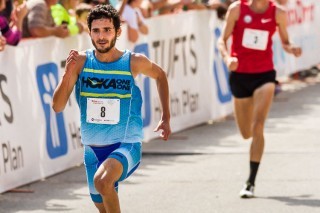
David Torrence, a Peruvian-American middle distance runner who competed at the 2016 Olympic Games, was found dead in a swimming pool at an apartment complex in Scottsdale, Ariz. He was 31 years old.
According to the Arizona Republic, Torrence was found at 7:30 a.m. on Monday morning. He was pronounced dead at the scene. Police confirmed that there were “no obvious signs of foul play.” However, they are still investigating the cause of death and it will be to the Maricopa County Medical Examiner’s Office to determine exactly how Torrence died.
Torrence was from California, where he ran collegiately at UC Berkeley. He was sponsored by HOKA ONE ONE. Originally he trained for the U.S. Olympic team before switching to Peru, where his mother holds citizenship. He made the 1500-meter final at the 2016 Olympics and recently set Peruvian national records in the 1500 and mile. He had recently come to Arizona on a training trip.
RELATED: The David Torrence Story
Torrence was well-liked among fellow runners and fans of the sport. Many took to Twitter to tell stories and share their grief of his passing.
Fellow HOKA athlete Kyle Merber announced they would name the Long Island Mile race he organizes every year after Torrence. He was the two-time champion of that event and a good friend of Merber’s.
Today we lost an amazing athlete and an even greater friend pic.twitter.com/TDrD0mLkUn
— Kyle Merber (@TheRealMerb) August 29, 2017
I can’t even comprehend right now. @David_Torrence was with us a month ago and always made the boys smile and laugh. We love & will miss u. pic.twitter.com/2KNixfiI4J
— Stephanie Bruce (@Steph_Rothstein) August 29, 2017
On a long run years ago Jason and I named our favorite runners to root for. #DT made our list. I’m so glad I had the chance to tell him.
— Jenny Simpson (@trackjenny) August 29, 2017
William and I were lucky to have shared so much life with David. We love him like family. None of this makes sense. pic.twitter.com/CLtFA7snMy
— Aisha Praught Leer (@aishapraught) August 29, 2017
The post Runners Mourn Olympian David Torrence’s Death At 31 appeared first on Competitor.com.
August 28, 2017
FitBit’s First Smartwatch Ionic Is Now Available For Pre-Sale
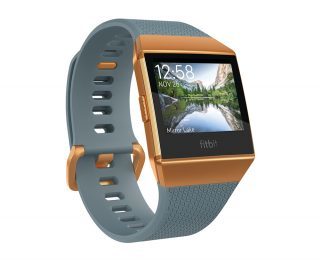

FitBit announced an exciting new suite of wellness products today: the Ionic, FitBit’s first smartwatch, FitBit Flyer, the company’s first entry into the wireless headphone space, and an updated WiFi smart scale, the Aria 2. These three products seamlessly connect with one another to offer an easy and individually tailored way to track and attain your fitness goals.
The company describes its newest smartwatch offering as “a health and fitness first platform, [the] Ionic offers a highly personalized experience not previously seen in other smartwatches. Ionic builds on Fitbit’s health and fitness expertise with a new relative SpO2 sensor, making it possible to track deeper health insights like sleep apnea in the future, industry-leading GPS tracking, on-device dynamic workouts, improved heart rate tracking, and water resistance up to 50 meters.
“Smart” features include contactless payments, onboard music, smart notifications, and a variety of popular apps and clock faces available in the Fitbit App Gallery. Ionic also has all the core features our users love from Fitbit like 4-plus-day battery life, automatic activity and sleep tracking, and cross-platform compatibility. Ionic is available for pre-sale today on Fitbit.com and in retailers globally starting October 2017, with a new Fitbit Ionic adidas special edition device coming in 2018.

Fitbit is also adding a sleek pair of headphones to the family—Flyer. The musical addition comes in white and rose gold, reminiscent of their special edition Charge 2 that also offers the classic-looking colorway. “As we launch our first smartwatch with on‐device music, providing quality wireless headphones to better help users reach their goals is a natural extension of our product offerings,” said James Park, CEO and co‐founder of Fitbit.

Finally, the Aria 2 is described as a FDA-regulated medical device. “Fitbit Aria 2 has been reengineered for greater accuracy, easy setup, improved interface to get you started faster on your health journey.” Using wifi and Bluetooth, it connects to the FitBit app to make tracking your progress easy.
“The Ionic offers an amazing array of functionality in a beautifully designed package. I am most impressed with the ability to use the Ionic in a range of fitness settings,” explains Rebecca Warren, Women’s Running editor-in-chief, who attended the product launch event. “It performed fantastically well in a 90-minute pool workout, including being able to use the touch screen underwater. It works well as a smartwatch too; I love the ability to go for a run and have my music, a personal coach and a credit card all on my arm, with no need to bring my phone along for the ride.”
Regarding the Flyer, Warren says, “I always struggle with ear phones falling out when I run, so the unique ability to customize each earpiece on the Flyers means I can concentrate on my form instead of my earbuds.”
This story originally appeared on Womensrunning.com.
The post FitBit’s First Smartwatch Ionic Is Now Available For Pre-Sale appeared first on Competitor.com.
Frustrations From A Back-Of-The-Pack Runner
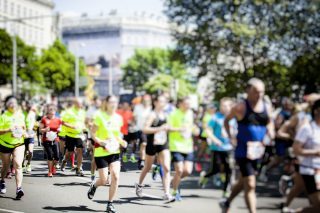
There is no shame in being a “back-of-the-pack” runner. Just being out there is a sign of strength. However, as a back-of-the-packer, I’ve witnessed and experienced several things that make me wonder why the heck I bother to run at all. During a recent race, as I ran in the back, swearing in my head about how frustrating running was that day, I came up with a list of things that bug me.
Getting passed by little kids
While running a 5K through Amish country, I was passed by a 6-year-old boy in full Amish dress, besides the shoes. Mind you, his running shoes were way cooler than mine. I was also outpaced by Amish girls running in full-length dresses. Little kids in long sleeves and dresses shouldn’t be able to outrun me when it’s 90 degrees outside!
Competing against dilly-dalliers
That same weekend, I finished a half marathon behind a group of women who stopped and took pictures with every farm animal along the course. They must have been city girls to be so fascinated by cows and horses. I kept passing them when they stopped, yet somehow they managed to beat me to the finish line.
Running slower than runners with wheels
A woman pushing a twin baby stroller can run faster than me. I guess pushing the stroller makes her stronger. I’ve also been passed by someone pushing a wheelchair with an adult rider. While I admire them for being out running and the strength it takes to push a wheelchair for miles, I thought that running unencumbered would give me an advantage. I guess not.
Shortage of supplies
Some races aren’t adequately prepared for all participants. Nothing is more frustrating than getting to an aid station that has run out of replenishment. During a race on a particularly hot and humid day, organizers had left chests full of ice on the route to help us keep cool. They were empty by the time I got to them because all of the faster runners had reached them first. And we in the back were left to sweat.
Cut-off times
Some longer races don’t advertise a cut-off time, yet seem frustrated by those of us who finish too slowly. I ran a 10-mile race where I finished second to last, and the finish line was almost completely dismantled before I ever got there. It’s demoralizing to have everyone and everything, including the refreshments, packed up before I can even catch my breath and grab a banana!
Comments
While running, I’ve had people yell, “Why are you so slow?” But until you are out running with me, I don’t want to hear it. It makes me want to direct certain gestures towards them that shouldn’t be made around small children.
I enjoy being a runner, but at times it can be very demoralizing to be a back-of-the-packer. Although questioning our abilities as athletes is normal, I’ve learned that we don’t have to let it rule our lives. I’ve also learned that my only real competition is myself.
RELATED: If You Run Slow, Who Cares?
The post Frustrations From A Back-Of-The-Pack Runner appeared first on Competitor.com.
A Guide To Game Of Thrones Best (And Worst) Running Buddies

Warning: The following post contains spoilers about Season 7 of Game of Thrones … including Sunday night’s season finale. If you didn’t watch or haven’t watched, consider yourself warned. But go ahead and read anyway, because you’re obviously a runner and a Game of Thrones fan.
We rang in the start of Season 7 back in July with a post about the best places to run in Westeros.
But so much has happened since then. We finally saw the dragons in full-blown action. And it was glorious. But the Night King has one of his own now … setting the stage for what we all hope will be a satisfying series finale when Season 8 debuts.
But that is a long way’s off. And until then, you’re going to want to stay in shape. That means long runs contemplating dragon vs. wight dragon, Jon and Dany’s (ahem, relationship) and where exactly Bran fits into all of this. To also help you pass the time, we offer some of the best and worst fictitious workout partners you can chose from the Seven Kingdoms.
Best training partner

GIF: HBO/Game of Thrones
Easy choice here with Gendry. Not only does he have the stamina to row for years, Jon Snow declared him the fastest of the “North-of-the-Wall-Avengers” who went looking for their very own pet wight to show off in King’s Landing. When the storm brought the army of the dead, it was Gendry, who on fleeted foot, made it back to East Watch to inform Davos to send the raven. Honorable mention to Grey Worm, though the conversation would probably be stilted.
Worst training partner(s)

GIF: HBO/Game of Thrones
Another easy choice here. The army of the dead is a slow-moving horde that will do nothing to push you to a PR. It took them more than two years—two years!—to go from Hardhome to the Wall. Kilian Jornet summited Everest twice in a week. Time to cut them out of your life. Unless you’re going to incorporate some javelin training. Then you can hang with the Night King. Dude has a sick arm.
Best cross-training partner

GIF: HBO/Game of Thrones
Brienne of Tarth won’t take your lazy attitude. When you want to reach for the “snooze” button, she’ll smack you down like you were Podrick and come back for seconds. We’ve seen her stamina in action. You’ve got to be in good shape to go toe-to-toe with The Hound and come out on top.
Laziest training partner

GIF: HBO/Game of Thrones
We love her Grace, Daenerys of the House Targaryen, the First of Her Name, The Unburnt, Queen of the Andals, the Rhoynar and the First Men, Queen of Meereen, Khaleesi of the Great Grass Sea, Protector of the Realm, Lady Regnant of the Seven Kingdoms, Breaker of Chains and Mother of Dragons. But frankly, we’re out of breath before we’re through saying her name and she never wants to go for a run. She just flies everywhere now. If nothing, she damn sure knows how to make an entrance.
Worst training coach

GIF: HBO/Game of Thrones
Oh, poor Rickon Stark. If only 5Ks, halfs and full marathons were simple straight lines, you might have something to contribute. But most courses require even the gentlest listing in one direction, let alone the ability to move serpentine. Even tracks have slight curves. But your Zoolander-esque inability to turn left … or right, for that matter … led to your untimely end and doomed your run-coach business before it even started.
Funniest running buddy

GIF: HBO/Game of Thrones
Who wouldn’t want to swap stories for 26.2 with Tormund Giantsbane? He’s a ginger quote machine and we’re so glad The Hound pulled him from what appeared to be a cold and icy finish. Who else could deliver motivation like “Walking’s good, fighting’s better, f-ing’s best.” Here’s hoping he and the aforementioned Brienne find their happy ending. And we hope to see him emerge in Season 8 from the melted Wall. Honorable mention to Bronn, who can weave tales of epic travels and is always quick with a joke.
Best/worst tri partner

GIF: HBO/Game of Thrones
We know Theon can swim. He’s Ironborn (Ironman … Ironborn … see what we did there?). The salt flows through his blood. And we know his cardio skills are solid. Fighting a sea battle takes it out of you. But unfortunately, he’s damaged goods. And when things get tough in the 60th mile, he’s more likely to cut and run than help you push through the fatigue. Here’s hoping he gets another redeeming moment (we do give credit for saving Sansa) before his time is up. He took a big step in that direction in the finale. But he’s let us down before. Proceed at your own risk.
The post A Guide To Game Of Thrones Best (And Worst) Running Buddies appeared first on Competitor.com.
Ryan Hall's Blog
- Ryan Hall's profile
- 21 followers



